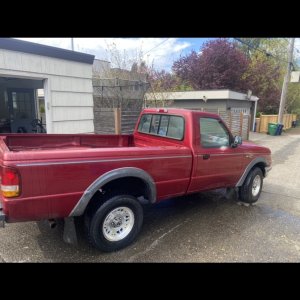TenSeven
New Member
- Joined
- Apr 1, 2015
- Messages
- 98
- Reaction score
- 0
- Points
- 0
- Transmission
- Automatic
I bought a dirty, ugly looking 85 Ranger 2.8 that "used to run". Cleaned it up, replaced water pump and oil pump, a few gaskets including intake manifold and carb., tune up parts and enough new paint to make it look like it runs great.
Managed to get it started. Ran and idled great, no smoke in exhaust no gross leaks, awesome, stoked!, shut it down after a few minutes to check it over. Noticed a fog of moisture wafting out of the carb, no odor of fuel, heard sizzling/bubbling coming from beneath the carb and noticed the same bubbling outside from the carb base. Seems there is coolant in the intake manifold.
Fired it up again and let it idle. 195 degrees at the radiator inlet house from engine. Then, pop! The upper radiator hose blew off. Ok, wasn't tight enough. Tightened it back on. Started it up, idled for about 20 minutes, 200 degrees same spot the BOOM! The radiator filler neck with the cap still attached blew off. Shut off but it continued to violently!! diesel for several minutes then finally quit. Besides the obvious blown radiator there is also a few drips of coolant from the passenger header end
Radiator mechanic showed me that the upper tank was under so much pressure it bowed out before it blew. Hmmm, why didn't it vent first? Checked the vent hose, clear. Checked the cap, works, 13lbs, but, I think there was a 'possibility' that the cap spring could not retract far enough to allow pressure to bypass.
Read that coolant in the intake manifold could be caused by a poor fitting intake manifold gasket.
So, replaced radiator cap with one that for sure retracts far enough and dropped it down to 7lbs. Surgically replaced the intake manifold gasket making sure to add a thick bead of sealant front and back. Got it all cleane d up and looking good again.
It briefly started then would only turn over, nothing. Now, just from turning it over, there is coolant dripping from 'both' header ends! All plugs are wet.
So s**t. Just another bad intake manifold gasket install or much worse, cracked heads!?
To go from a short time of running great to blowing up the radiator and coolant leaking out of both exhausts, geezus. Was it just a poor fitted gasket or an incorrect radiator cap or an overheated and violently dieseling engine that cracked it's heads?
I'll do the 'glove test' and a compression test but I'm not hopefull at all.
What do you guys think?
Thanks
Managed to get it started. Ran and idled great, no smoke in exhaust no gross leaks, awesome, stoked!, shut it down after a few minutes to check it over. Noticed a fog of moisture wafting out of the carb, no odor of fuel, heard sizzling/bubbling coming from beneath the carb and noticed the same bubbling outside from the carb base. Seems there is coolant in the intake manifold.
Fired it up again and let it idle. 195 degrees at the radiator inlet house from engine. Then, pop! The upper radiator hose blew off. Ok, wasn't tight enough. Tightened it back on. Started it up, idled for about 20 minutes, 200 degrees same spot the BOOM! The radiator filler neck with the cap still attached blew off. Shut off but it continued to violently!! diesel for several minutes then finally quit. Besides the obvious blown radiator there is also a few drips of coolant from the passenger header end
Radiator mechanic showed me that the upper tank was under so much pressure it bowed out before it blew. Hmmm, why didn't it vent first? Checked the vent hose, clear. Checked the cap, works, 13lbs, but, I think there was a 'possibility' that the cap spring could not retract far enough to allow pressure to bypass.
Read that coolant in the intake manifold could be caused by a poor fitting intake manifold gasket.
So, replaced radiator cap with one that for sure retracts far enough and dropped it down to 7lbs. Surgically replaced the intake manifold gasket making sure to add a thick bead of sealant front and back. Got it all cleane d up and looking good again.
It briefly started then would only turn over, nothing. Now, just from turning it over, there is coolant dripping from 'both' header ends! All plugs are wet.
So s**t. Just another bad intake manifold gasket install or much worse, cracked heads!?
To go from a short time of running great to blowing up the radiator and coolant leaking out of both exhausts, geezus. Was it just a poor fitted gasket or an incorrect radiator cap or an overheated and violently dieseling engine that cracked it's heads?
I'll do the 'glove test' and a compression test but I'm not hopefull at all.
What do you guys think?
Thanks














